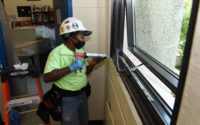While the public universities continue to put out projects, the private university market has been very quiet, Dordai says. With endowments having been hit hard by the recession, schools began to cut back. One of the first line items impacted at many private schools was new facilities and projects.

DARGHAM
Cornell University in Ithaca, New York illustrates the dichotomy between the public and private university market. The university is composed of contract colleges that receive state funding and private endowed colleges, which do not.
“At Cornell we have scaled back considerably from even just a year ago,” explains Kyu-Jung Whang, Vice President for Facilities Services. Projects in either design or construction total $800 million, with $250 million on the endowed side and the remaining $550 million on the contract college side.

WHANG
On the endowed side the University enacted a construction pause last February. Only projects already under construction are proceeding. One $8 million project is in the planning stage and that project is 100 percent donor funded.
“State funding for the contract college side has not stopped,” Whang says. ‘”We are now in the third year of the current 5-year plan and the indication is that we are going to get all the funding that is committed in the 5-year plan.”
Princeton University’s endowment declined 23.7 percent to 12.6 billion, down from $16.3 billion in 2008. The drop set off a series of budget cuts.
Over the last 12 months the University 10-year capital plan dropped from $3.1 billion to $2.3 billion. “This was done by taking projects of lesser value to the university and deferring them,” explains Ann St. Mauro, assistant vice president of design and construction. “We have also slowed down some of our projects to spread them out over the timeframe.”

WEINSHALL
Of the $2.3 billion, 29 percent is completed or in process, 51 percent is under design or has not started construction and the remaining amount is for an annual program investing in maintenance and renovation projects, St. Mauro explains.
Some universities are using the economic slowdown to plan and design projects which will allow them to move forward once conditions improve. “We are seeing more early design studies for buildings that allow a university to identify the size of the project, its budget and that allows them to go into fund raising but not necessarily full design services,” Dordia says.
Beyond design and construction, colleges and universities are focused on maintaining and upgrading their existing facilities. CUNY has committed $260 million to critical maintenance projects across its 23 campuses.
Cornell and Princeton are working on maintenance projects and system upgrades, such as the replacement of HVAC systems to increase energy efficiency. “For us to exist in a competitive market, we need to take care of the buildings we have,” Whang says.




